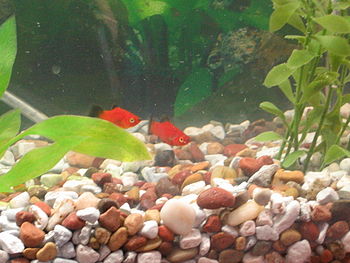 |
| Two red wag platies (Xiphophorus maculatus) (Photo credit: Wikipedia) |
Livebearers are a very common fish in many smaller community tanks up to 20 - 25 gallons. They are relatively passive and provide much interest because they bear live fry that is often large enough to live on their own immediately, assuming they can find a suitable place to hide right away. If they are not, they are rapidly eaten by the rest of the aquarium occupants, including their mother.
There are essentially four types of livebearers found in the small aquarium; guppies, platies, swordtails, and mollies.
Guppies have evolved quite rapidly and been bred for a number of color variations and fin shapes. They are extremely popular and are often the first fish a novice aquarist may keep. Swordtails and platies share the same genus - Xiphophorus, so are very closely related. The swordtails are more streamlined in general and are interesting because of the "sword" that often extends from the tail fin. Often they are more active and aggressive than platies. The platy is usually much stockier, taller and shorter and comes in just as many colors as the swordtails. Mollies can become quite large in comparison with the other three and also is actually a brackish water fish. Believe it or not, mollies have even been used to start a saltwater aquarium and show a little problem with adjusting to such drastic water differences.
Any livebearer species seems to have very energetic males. Because of this, any livebearers should be purchased in trios, two females to every male. The males need to be diverted otherwise they can wear a female down with constant attention. Luckily it is quite easy to differentiate a male from a female, the females have a fixed triangular fin at the base of the body, males have a gonopodium instead. This a special movable sword-shaped fin near the anus of the male. It is normally held parallel to the body. It is a movable appendage that rotates forward and forms an open tube to pass sperm packets to the female. Even a brand new fish keeper can identify between the sexes with a little careful observation in the pet store.
Livebearers females, especially guppies, can store the sperm packets passed to them by a male and become pregnant at a much later date. So even if a male has been there only briefly, it is not a surprise that suddenly a female is pregnant without any apparent cause. Another thing that can happen often found in swordtails, is that when there is a tank full of swordtails where there are no males present the dominant female may suddenly appear to change sexes and become a male.
Platies are the fish I generally use in a community aquarium, guppies seem to be a lot more fragile than they used to be. Probably as a result of the tremendous inbreeding that has occurred to define and create new combinations of colors and fins. The guppy is not the most sturdy fish to add to a new aquarium. Guppies are best added, if they are to be kept, well after the initial maturation of the biological filter is fully completed. There are much better fish to initiate a new fish tank, guppies are certainly not the best.
Swordtails are very active and swim continually. They are usually one of the larger fish and their constant swimming can cause havoc for much smaller fish. There is no doubt that if you plan on keeping the larger community fish like gouramis and angels the fast swimming swords can take care of themselves in most cases. Platies seem to be a bit more placid in an aquarium with small tetras and danios but are also large enough to take care of themselves with barbs and sharks. So even though the swords and the guppies may seem to have the flash, the platies do offer as many color varieties and seem to fit well with almost any small community aquarium.
http://www.noviceaquarist.com Dedicated to providing information required for the successful novice aquarist. Keep tropical fish alive and thriving in your first aquarium through the critical first six weeks and beyond. Visit my website for detailed information for the novice aquarist on all aspects of the beginning aquarium. Article Source: EzineArticles |

No comments:
Post a Comment